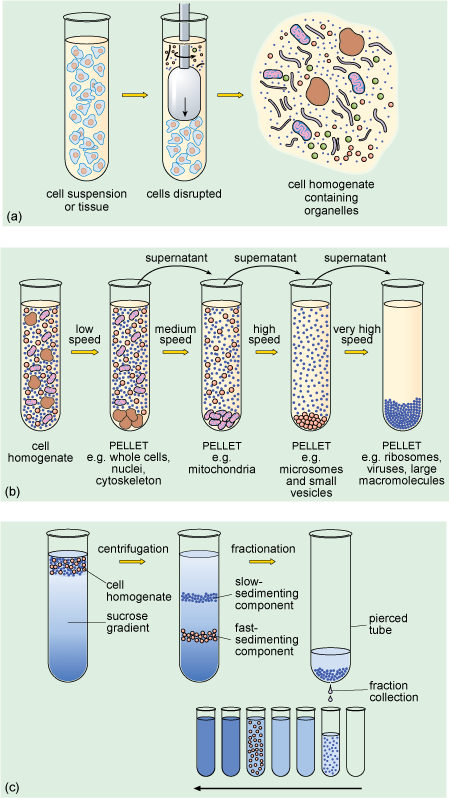Describe the Technique Used for Separating the Cell Organelles
Based on the type of pigments plastids are of three types. The technique is employed for the separation of enzymes RNA-DNA hybrids ribosomal subunit subcellular organelle etc.

A Tour Of The Cell Openlearn Open University
The most common cell separation techniques include.

. But before fractionation the tissue must be placed in a cold isotonic buffer solution this. The homogenate mixture is filtered removes large pieces of tissue that hadnt been broken up 3. Isotonic it must have the same water potential as the cells being broken up to.
Fluorescence-activated cell sorting FACS Density gradient centrifugation. Both methods use differential centrifugation to separate the mitochondrial and cytosolic fractions with a benchtop microcentrifuge and are completed in approximately 40 minutes post-cell harvest. In the process a tissue sample is first homogenized to break the cell membranes and mix up the cell contents.
Cell fractionation is the process in which cells are broken up and the different organelles they contain separate out. This is used to help us study cell structures and functions. Sity using a variety of centrifugation techniques.
Chloroplasts Chloroplasts are double membrane-bound organelles which usually vary in their shape. The main difference between the two centrifugation methods is the type of physical properties in which the process is based on. Cell fractionation is a two stage process which consists of.
2Describe how you would centrifuge a homogenate of heart muscle cells in order to isolate mitochondria. Although biochemical analysis requires disruption of the anatomy of the cell gentle fractionation techniques have been devised to separate the various cell components while preserving their individual functions. Cell fractionation is a procedure for rupturing cells separation and suspension of cell constituents in isotonic medium in order to study their structure chemical composition and function.
The addition of is View the full answer. It is routinely used in testing for genetic diseases as well as in the fields of forensics studies of ancestry and paternal testing. Extraction Homogenization and Centrifugation.
The purity and identity ofrecer Self-Test Questions 1Describe the procedures that researchers use to separate and isolate the different organelles of a cell. Cells in a tissue are broken open in a homogenizer the tissue is suspended in a cold buffer solution that has the same water potential as the tissue 2. Centrifugation is an effective way to separate cell organelles once the cell is lysed but before we get to this step we need a healthy population of whole cells.
To do this cell biologists have relied on a technique known as cell frac- tionation. Cell organelles can be separated by the method of differential centrifugation. The solution must be.
A quick and gentle way to obtain an enriched population of whole cells is through biomagnetic separation. Just as a tissue can be separated into its living constituent cell types so the cell can be separated into its functioning organelles and. THe first step includes disruption of cell and removal of cell wall through enzymatic hydrolysis.
Isopycnic centrifugation depends solely upon the buyout density and not on its shape size and time the size of the particle affecting only the rate at which it reaches its. Further the cells are homogenized which involves 5 steps homogenization filtration grinding sonication and solubilization. The filtrate is then centrifuged and spun at a low speed.
Cell fractionation involves 3 steps. Scientists Highly active in energy metabolism the. The sample of tissue containing the cells to be broken up must first be placed in a cold isotonic buffer solution.
Homogenisation is the biological term used to describe the breaking up of cells. Common characteristics used to isolate cells include cell size cell density cell shape and surface protein expression. This is especially true if a modern separation rack is used.
Describe a technique that could be used to. Which of the following centrifugation is used to separate certain organelles from whole cell. Polymerase chain reaction PCR is a technique that utilizes the principles of DNA replication to produce many copies of a specific segment of DNA.
The diagram shows one of these organelles seen under an electron microscope before and after it was placed in the hypotonic solution. I break open the cells. Differential centrifugation might be easier but density gradient centrifugation is able to sort.
Ii separate the organelles. Once isolated the mitochondria can be used in downstream applications such as apoptosis signal transduction and metabolic studies as well as to facilitate mitochondrial. B Isopycnic Centrifugation Technique.
2 b One group of organelles was placed in a hypotonic solution. PCR has many research and practical applications. A Ribosome 6 Starch c.
Arrange the following in order of decreasing size. Differential centrifugation is a common procedure in microbiology and cytology used to separate certain organelles from whole cells for further analysis of specific parts of cells. It is used for separating cells and organelles while density gradient centrifugation is used for molecules and particles.
Here cells are broken open and the cellular com- The Experiment ponents are separated on the basis of size mass and den- de Duve studied the distribution of enzymes in rat liver cells. Plastids are large membrane-bound organelles which contain pigments. Ice-cold to reduce the activity of enzymes that break down organelles.

2 Schematic Separation Of Organelles By Density Equilibrium Download Scientific Diagram

1 Schematic Separation Of Organelles By Differential Centrifugation Download Scientific Diagram

Cell Fractionation Definition Steps Methods Video Lesson Transcript Study Com
Comments
Post a Comment